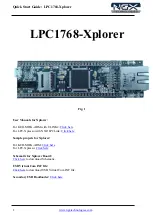
Chapter 4: UEFI BIOS
81
Isoc Mode
Select Enabled for Isochronous support to meet QoS (Quality of Service) requirements.
This feature is especially important for Virtualization Technology. The options are Disable,
Enable, and Auto.
Memory Configuration
Integrated Memory Controller (IMC)
Enforce POR
Select Enable to enforce POR restrictions on DDR4 frequency and voltage programming.
The options are POR and Disable.
PPR Type
Post Package Repair (PPR) is a new feature available for the DDR4 Technology. PPR
provides additional spare capacity within a DDR4 DRAM module that is used to replace
faulty cell areas detected during system boot. PPR offers two types of memory repairs.
Soft Post Package Repair (sPPR) provides a quick, temporary fix on a raw element in a
bank group of a DDR4 DRAM device, while hard Post Package Repair (hPPR) will take
a longer time to provide permanent repair on a raw element. The options are Auto, Hard
PPR, Soft PPR, and PPR Disabled.
Memory Frequency
Use this feature to set the maximum memory frequency for onboard memory modules.
The options are Auto
, 1866, 2000, 2133, 2400, 2666, and 2933.
Note: 2933 MHz memory
is supported by 2nd Gen Intel Xeon Scalable-SP (82xx/62xx series) processors only.
Data Scrambling for DDR4
Use this feature to enable or disable data scrambling for DDR4 memory. The options
are Auto, Disable, and Enable.
tCCD_L Relaxation
If Enabled, the tCCD_L overrides the SPD. When disabled, it is enforced based on
memory frequency. The options are Disable and
Auto.
2X REFRESH
This option allows the user to select 2X refresh mode. The options are Auto and Enabled.
Page Policy
Use this feature to set the page policy for onboard memory support The options are
Auto, Closed, and Adaptive.
IMC Interleaving
Use this feature to configure interleaving settings for the IMC (Integrated Memory Control
-
ler), which will improve memory performance. The options are Auto, 1-way Interleave,
and 2-way Interleave.
Содержание X11DPL-i
Страница 1: ...USER S MANUAL Revision 1 1a X11DPL i...
















































